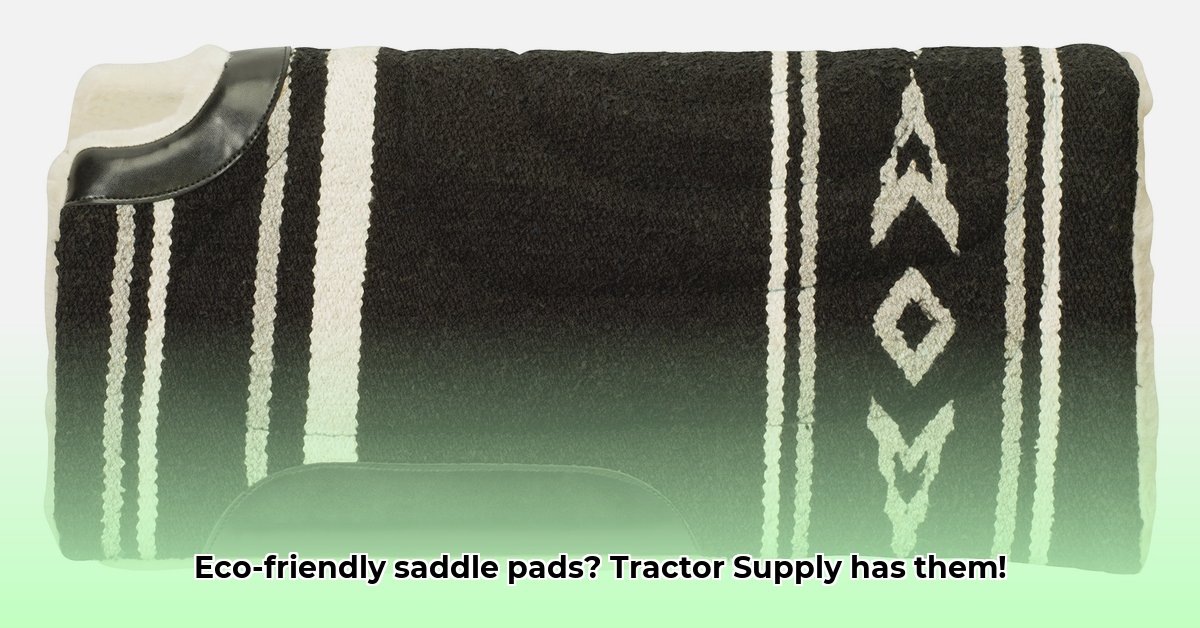
Finding the perfect saddle pad shouldn't come at the expense of the planet. This guide helps you navigate the world of eco-friendly saddle pads, whether you're shopping at Tractor Supply or exploring other retailers. We'll define sustainable practices in equestrianism, provide criteria for choosing sustainable saddle pads, and offer practical care tips to maximize their lifespan. Let's ride responsibly! For more on Tractor Supply's offerings, check out their rubber boot selection.
Choosing Sustainable Saddle Pads: A Rider's Guide to Eco-Friendly Choices
More and more equestrians are embracing sustainable practices, and choosing an eco-friendly saddle pad is a significant step. But what does "sustainable" truly mean in this context? It's about minimizing the environmental impact of your equipment throughout its entire lifecycle – from material sourcing to disposal. This conscious choice benefits both your horse and the planet.
Understanding Sustainable Agriculture in Equestrianism
Sustainable agriculture isn't limited to food production; it extends to all aspects of our interaction with the natural world, including equestrianism. It's about responsible sourcing of materials, minimizing waste, and promoting ethical manufacturing practices. Choosing a sustainable saddle pad directly contributes to these goals. Isn't it rewarding to know your riding gear reflects your values?
Identifying Truly Sustainable Saddle Pads
Several factors contribute to a saddle pad's sustainability. Here's what to look for:
Material Composition: Prioritize organic cotton, recycled polyester (rPET), or hemp. These materials often require fewer resources and harmful chemicals during production compared to conventional options like virgin polyester or nylon.
Certifications: Look for certifications like GOTS (Global Organic Textile Standard) or OEKO-TEX, which assure environmentally and socially responsible manufacturing practices. These certifications signify a commitment to sustainability beyond simple marketing claims. What could be more reassuring than third-party validation?
Manufacturing Transparency: Research the brand's commitment to ethical sourcing and manufacturing processes. Is the company transparent about its supply chain? Do they utilize fair labor practices? A company genuinely dedicated to sustainability will openly share this information.
Where to Buy Sustainable Saddle Pads: A Retailer Comparison
While Tractor Supply offers a range of saddle pads, it's crucial to examine the materials and manufacturing processes of each product to ensure they align with your sustainability criteria. Contact Tractor Supply directly to inquire about their sourcing and production practices for specific saddle pads. Don't hesitate to ask questions; this is how we encourage transparency and guide responsible choices.
Beyond Tractor Supply, numerous smaller companies specialize in eco-friendly equestrian products. Online reviews and brand websites can provide valuable insights. Comparative shopping empowers you to make an informed decision that benefits both your budget and your environmental footprint.
Caring for Your Sustainable Saddle Pad: Extending Its Life
Proper care extends the lifespan of your sustainable saddle pad, reducing waste and maximizing your investment. Always follow the manufacturer's instructions:
Gentle Cleaning: Hand washing with a mild, eco-friendly detergent is usually best for delicate sustainable materials.
Air Drying: Air drying is gentler than machine drying, preserving the fabric's integrity and prolonging its life. Avoid high heat, which can damage the fibers.
Preventive Care: Regularly inspect your saddle pad for wear and tear and address minor issues promptly to prevent further damage.
Alternatives to Traditional Saddle Pads: Creative and Sustainable Solutions
Consider alternative, sustainable choices:
Repurposing: Upcycle old, durable fabrics into a custom saddle pad. This inventive approach reduces textile waste and produces a unique, eco-conscious piece of equipment.
Secondhand Market: Explore buying used saddle pads in good condition. This reduces demand for new products and provides a cost-effective option.
Key Takeaways: Sustainable Riding for a Healthier Planet
- Choosing sustainable saddle pads contributes to a broader commitment to environmentally conscious practices within the equestrian world.
- Careful consideration of materials, certifications, and manufacturing processes is key to identifying truly sustainable saddle pads.
- Extending the lifespan of your saddle pad through proper care minimizes waste and reduces your environmental impact.
By making conscious choices about your equestrian equipment, you contribute to a more sustainable future for the sport you love. Let's ride on!